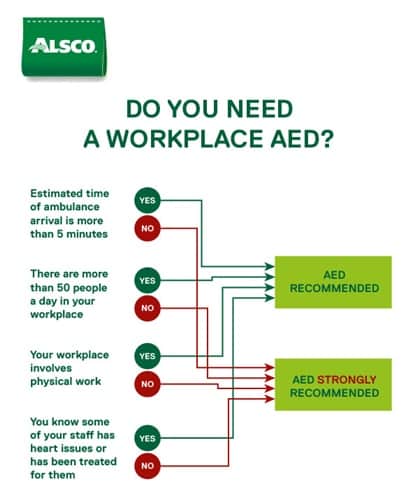One of the best decisions you can make when it comes to workplace safety is to get workplace AEDs installed. They should be easily reachable and there should be at least one AED on a building storey. While there is no direction and official legal requirement about its placement, here are the recommendations about where to place a defibrillator:
- One on each storey if you have a multi-storey workplace
- In the central, easy-to-access access area
- In secluded hard to reach areas where it is difficult to arrive with an AED quickly
- In areas that are frequent and/or the cardiac arrest is more likely to happen
- In the lobby or reception
- Near the phone
When you contact Alsco New Zealand and tell us you want portable AEDs to be installed in your workplace, our experienced representatives will help you decide where and how to position them. They will also install them, check on them and regularly re-check them. Rent your workplace AED today.
What Height Should a Defibrillator Be Placed?
All of your workplace AEDs need to be accessible and visible. Everybody should be able to reach the handle of the defibrillators without the danger of it to drop down.
This means that it should be positioned at no more than 120 cm of height. Also, it should not be at less than 40 cm. In this way, people who are using wheelchairs can also reach it without problems. For the same reason, the unobstructed side reach should be no more than 25 cm.
The height is not the only requirement when it comes to positioning the defibrillator. There are others, as well:
- It should not be in a locked compartment.
- It should never be blocked with furniture, plants or other items.
- It should always be marked with proper signs.
Feel free to download Alsco New Zealand AED sign in as many copies as you need. They will help you in the time of crisis when people are not quick to think, but they need to act fast.
Is It a Legal Requirement to Have a Defibrillator at Work?
There is not a legal requirement for you to have an AED at work, but there is a recommendation that all workplaces have at least one. Moreover, New Zealand government is trying to spread awareness about the publicly placed AEDs. So, does your workplace need an AED or more?
Find out by following this flowchart:

How Does a Defibrillator Work?
The defibrillator shocks the heart into working properly. When the heart’s ‘electrical work’ doesn’t work properly. Regular electrical impulses are essential for the heart’s function, because they make the heart contract.
The contractions make the heart pump the blood and feed all the organs with nutrients and oxygen. No electrical impulses – no contractions – no blood flow. It is not that the heart needs to contract. It needs to contract in the precise way. Irregular contractions are heart palpitations or fibrillations.
It is all in the name. De-fibrillation means interrupting the fibrillation of the heart. The electrical shock that is administered to the heart stops it for a split second so that the heart can restart at a regular rate.
First, when you attach the pads on a person and push the button, the AED will check their pulse. If the pulse is OK, the AED will not release the current. The same will happen if the AED detects no pulse. The shock will be administered only and only if there is irregular heartbeat that poses danger to the patient.
What Rhythms Are Shockable?
Shockable rhythms are those rhythms of the heart that are caused by the electrical activity. This mainly includes ventricular fibrillation and the ventricular tachycardia, but also supraventricular tachycardia.
Since they are caused by the irregular electrical activity, they can benefit from the restarting. On the other hand, asystole and the Pulseless Electrical Activity are not shockable since they are not the result of bad ‘electricity’ but rather the blood supply to the heart, clogged or disrupted arteries.
Who Is Allowed to Use AED?
Anyone who is around a person that is suffering a cardiac arrest should use AED. You don’t need medical training to use it and you don’t have to worry that you will hurt or kill anybody. Modern day AEDs come with easy instructions and they are designed so that even untrained people can use them.
They analyse the heartbeat on their own and administer the shocks only if they are necessary. They choose the power of the electrical impulse. All you need to do is make sure it is attached properly.
Can a Defibrillator Kill You?
No. AED doesn’t kill people. You should not worry that you will hurt the person that is in cardiac arrest by using AED. AED can hurt a person that has a normal heart rate. However, if and when an AED analyser checks the heart rate and sees that there are no irregularities, it will not administer the shock.
Even if the AED fired, which is extremely unlikely, it is almost impossible that it would kill a person. The electrical shock should have to be released in such a tiny time-window within the heart cycle that it is almost impossible that it would be lethal.
With all this in mind, it is obvious that having an AED in the workplace is a matter of wishing the best for your workplace and your employees. Adding this essentially important level of workplace safety doesn’t even have to be expensive, or a capital investment.
You can rent your defibrillators. Alsco New Zealand offers AEDs that are perfect for the workplace. We install them, show you how they work and regularly check them from time to time, to make sure they are fully operational.
In this way, you just pay an affordable annual fee. You can always decide that you don’t want them anymore or that you need more or less of them. We are flexible!
Call Alsco New Zealand today and get your AEDs as soon as possible.
Photo courtesy of Flickr Images by Cliff Johnson






